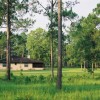 Wildfire is one of the most serious and publicized challenges facing interface forest management. Wildfires can change forest vegetation, affect human health, and cause millions of dollars’ worth of damage to homes, businesses, timber, and tourism. This 5-page fact sheet outlines tips for the firewise community development, design of structures, landscaping and fuel reduction. Written by Bruce Hull, Sarah F. Ashton, Rien M. Visser, and Martha C. Monroe, and published by the UF Department of School of Forest Resources and Conservation, August 2012.
Wildfire is one of the most serious and publicized challenges facing interface forest management. Wildfires can change forest vegetation, affect human health, and cause millions of dollars’ worth of damage to homes, businesses, timber, and tourism. This 5-page fact sheet outlines tips for the firewise community development, design of structures, landscaping and fuel reduction. Written by Bruce Hull, Sarah F. Ashton, Rien M. Visser, and Martha C. Monroe, and published by the UF Department of School of Forest Resources and Conservation, August 2012.
http://edis.ifas.ufl.edu/fr249
Tag: Fire and the Home
Developing Land in Florida with Fire in Mind: Recommendations for Designers, Developers, and Decision Makers (FOR63/FR059)
 In 1998, fire destroyed or damaged 330 homes and businesses in Florida. Losses totaled more than $800 million. In some places, homes were saved by fire-fighting crews, or where the right decisions were made by builders or designers. With advance planning, architects and developers can do a great deal to reduce wildfire risk for those living and working in Florida. This 5-page fact sheet was written by Martha C. Monroe and Susan Marynowski, and published by the UF Department of School of Forest Resources and Conservation, September 2012.
In 1998, fire destroyed or damaged 330 homes and businesses in Florida. Losses totaled more than $800 million. In some places, homes were saved by fire-fighting crews, or where the right decisions were made by builders or designers. With advance planning, architects and developers can do a great deal to reduce wildfire risk for those living and working in Florida. This 5-page fact sheet was written by Martha C. Monroe and Susan Marynowski, and published by the UF Department of School of Forest Resources and Conservation, September 2012.
http://edis.ifas.ufl.edu/fr059
FOR-179/FR249 Forest Management in the Interface: Reducing Fire Risk
FOR-179, a 6-page illustrated fact sheet by Bruce Hull, Sarah F. Ashton, Rien M. Visser, and Martha C. Monroe, describes qualities of firewise communities, structures, and landscapes in proximity with fire-dependent ecosystems, and techniques for fuel reduction. Includes references. Published by the UF School of Forest Resources and Conservation, July 2008.
http://edis.ifas.ufl.edu/FR249
